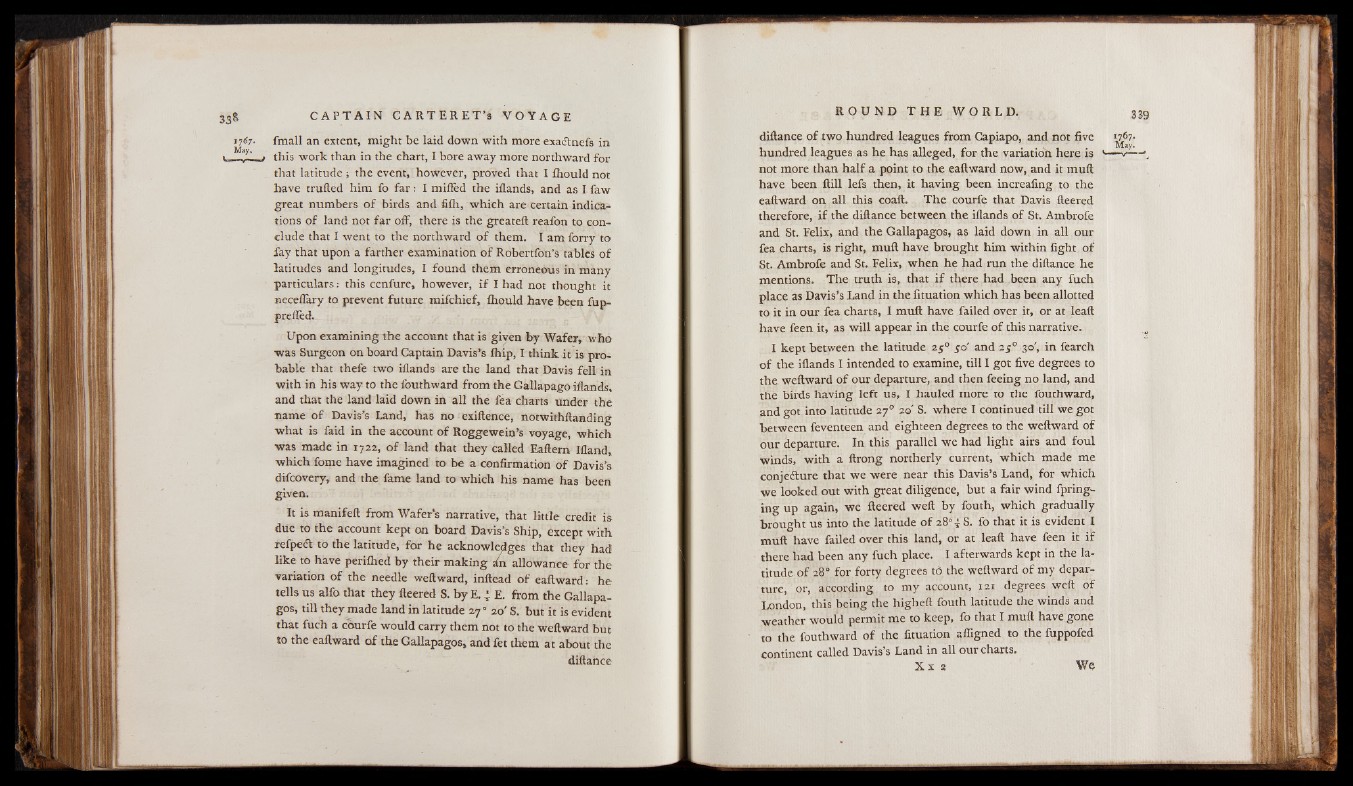
33s
17<57• fmall an extent, might be laid down with more exa&nefs in
■ M*~ ■ this work than in the chart, I bore away more northward for
that latitude ; the event, however, proved that I fhould not
have trailed him fo f a r : I milled the iflands, and as I faw
great numbers o f birds and filh, which are certain indications
of land not far off, there is the greateft reafon to conclude
that I went to the northward o f them. I am forry to
fay that upon a farther examination of Robertfon’s tables of
latitudes and longitudes, I found them erroneous in many
particulars: this cenfure, however, i f I had not thought it
necellary to prevent future mifchief, Ihould have been fup-
prefied.
Upon examining the account that is given by Wafer, who
was Surgeon on board Captain Davis’s flrip, I think it is probable
that thefe two illands are the land that Davis fell in
with in his way to the fouthward from the Gallapago illands,
and that the land laid down in all the fea charts under the
name o f Davis’s Land, has no exiltence, notwithftanding
what is faid in the account o f Roggeweio’s voyage, which
was made in 1722, o f land that they called Eaftern Illand,,
which fome have imagined to be a confirmation o f Davis’s
difcovery, and the fame land to which his name has been
given.
It is manifell from Wafer’s narrative, that little credit is
due to the account kept on board Davis’s Ship, except with
refpeCt to the latitude, for he acknowledges that they had
like to have perifhed by their making in allowance for the
variation o f the needle weftward, inllead o f eallward: he
tells us alfo that they fleered S. by E. 4 E. from the Gallapa-
gos, till they made land in latitude 27 ° 20' S. but it is evident
that fuch a courfe would carry them not to the weftward but
to the eallward o f the Gallapagos, and let them at about the
diftance
diflance o f two hundred leagues from Capiapo, and not five 1767-
hundred leagues as he has alleged, for the variation here is > —
not more than half a point to the eallward now, and it mull
have been Hill lefs then, it having been increafing to the
eallward on all this coaft. The courfe that Davis fleered
therefore, i f the diflance between the illands of St. Ambrofe
and St. Felix, and the Gallapagos, as laid down in all our
fea charts, is right, mull have brought him within fight of
St. Ambrofe and St. Felix, when he had run the diflance he
mentions. The truth is, that i f there had been any fuch
place as Davis’s Land in the fituation which has been allotted
to it in our fea charts, I mull have failed over it, or at leaft
have feen it, as will appear in the courfe of this narrative.
I kept between the latitude 250 50' and 250 30', in fearch
o f the illands I intended to examine, till I got five degrees to
the weftward o f our departure, and then feeing no land, and
the birds having left us, I hauled more to the fouthward,
and got into latitude 270 20' S. where I continued t ill we got
between feventeen and eighteen degrees to the weftward o f
our departure. In this parallel we had light airs and foul
winds, with a ftrong northerly current, which made me
conjecture that we were near this Davis’s Land, for which
we looked out with great diligence, but a fair wind fpring-
ing up again, we fleered weft by fouth, which gradually
brought us into the latitude o f 28° 4 S. fo that it is evident I
mull have failed over this land, or at leaft have feen it i f
there had been any fuch place. I afterwards kept in the latitude
o f 28° for forty degrees to the weftward o f my departure,
or, according to my account, 121 degrees weft of
London, this being the higheft fouth latitude the winds and
weather would permit me to keep, fo that I muft have gone
to the fouthward o f the fituation afligned to the fuppofed
continent called Davis’s Land in all our charts.
X x a We